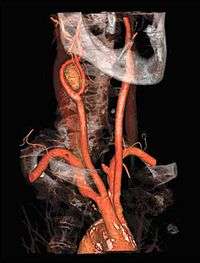Bolus tracking

Bolus tracking is a technique used in computed tomography imaging, to visualise vessels more clearly. A small bolus of radio-opaque contrast media is injected into a patient via a peripheral intravenous cannula. Depending on the vessel being imaged, the volume of contrast is tracked using a region of interest (abbreviated "R.O.I.") at a certain level and then followed by the CT scanner once it reaches this level. Images are acquired at a rate as fast as the contrast moving through the blood vessels.
Applications
This method of imaging is used primarily to produce images of arteries, such as the aorta, pulmonary artery, cerebral, carotid and hepatic arteries. The image shown illustrates this technique on a sagittal MPR (multi planar reformat). The image is demonstrating the blood flow through an abdominal aortic aneurysm or AAA. The bright white on the image is the contrast. You can see the lumen of the aorta in which the contrast is contained, surrounded by a grey 'sack', which is the aneurysm. Images acquired from a bolus track, can be manipulated into a MIP (maximum intensity projection) or a volume rendered image.
See also
References
- Hiroshi Kondo, Masayuki Kanematsu, Satoshi Goshima, Toshiharu Miyoshi, Yoshimune Shiratori, Minoru Onozuka, Noriyuki Moriyama and Kyongtae T. Bae: MDCT of the Pancreas: Optimizing Scanning Delay with a Bolus-Tracking Technique for Pancreatic, Peripancreatic Vascular, and Hepatic Contrast Enhancement, American Journal of Roentgenology Full text online
- Filippo Cademartiri, MD, Koen Nieman, MD, Aad van der Lugt, MD, PhD, Rolf H. Raaijmakers, MD, Nico Mollet, MD, Peter M. T. Pattynama, MD, PhD, Pim J. de Feyter, MD, PhD and Gabriel P. Krestin, MD, PhD: Intravenous Contrast Material Administration at 16–Detector Row Helical CT Coronary Angiography: Test Bolus versus Bolus-tracking Technique, Radiology Online